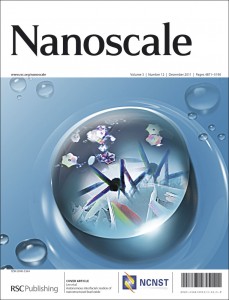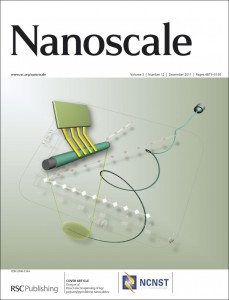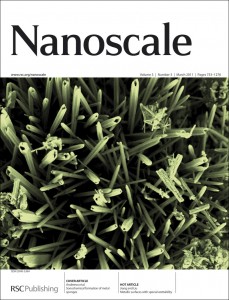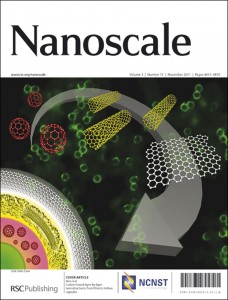Top 25 most-read Nanoscale articles for Q3
Cu2ZnSnS4 nanocrystals and graphene quantum dots for photovoltaics
Jun Wang, Xukai Xin and Zhiqun Lin
DOI: 10.1039/C1NR10425J
The role of nanomaterials in redox-based supercapacitors for next generation energy storage devices
Xin Zhao, Beatriz Mendoza Sánchez, Peter J. Dobson and Patrick S. Grant
DOI: 10.1039/C0NR00594K
Inorganic nanostructures grown on graphene layers
Won Il Park, Chul-Ho Lee, Jung Min Lee, Nam-Jung Kim and Gyu-Chul Yi
DOI: 10.1039/C1NR10370A
Graphene edges: a review of their fabrication and characterization
Xiaoting Jia, Jessica Campos-Delgado, Mauricio Terrones, Vincent Meunier and Mildred S. Dresselhaus
DOI: 10.1039/C0NR00600A
In situ self-assembly of mild chemical reduction graphene for three-dimensional architectures
Wufeng Chen and Lifeng Yan
DOI: 10.1039/C1NR10355E
Conjugated polymers/semiconductor nanocrystals hybrid materials—preparation, electrical transport properties and applications
Peter Reiss, Elsa Couderc, Julia De Girolamo and Adam Pron
DOI: 10.1039/C0NR00403K
Mesoporous silica nanoparticles for bioadsorption, enzyme immobilisation, and delivery carriers
Amirali Popat, Sandy Budi Hartono, Frances Stahr, Jian Liu, Shi Zhang Qiao and Gao Qing (Max) Lu
DOI: 10.1039/C1NR10224A
Li ion battery materials with core–shell nanostructures
Liwei Su, Yu Jing and Zhen Zhou
DOI: 10.1039/C1NR10550G
Semiconductor nanostructure-based photovoltaic solar cells
Genqiang Zhang, Scott Finefrock, Daxin Liang, Gautam G. Yadav, Haoran Yang, Haiyu Fang and Yue Wu
DOI: 10.1039/C1NR10152H
Controlled assembly of plasmonic colloidal nanoparticle clusters
José M. Romo-Herrera, Ramón A. Alvarez-Puebla and Luis M. Liz-Marzán
DOI: 10.1039/C0NR00804D
Quantum sized, thiolate-protected gold nanoclusters
Rongchao Jin
DOI: 10.1039/B9NR00160C
Transparent and flexible electrodes and supercapacitors using polyaniline/single-walled carbon nanotube composite thin films
Jun Ge, Guanghui Cheng and Liwei Chen
DOI: 10.1039/C1NR10424A
Engineered nanoparticles for biomolecular imaging
Morteza Mahmoudi, Vahid Serpooshan and Sophie Laurent
DOI: 10.1039/C1NR10326A
2D materials: to graphene and beyond
Rubén Mas-Ballesté, Cristina Gómez-Navarro, Julio Gómez-Herrero and Félix Zamora
DOI: 10.1039/C0NR00323A
Surfactant-assisted, shape-controlled synthesis of gold nanocrystals
Junyan Xiao and Limin Qi
DOI: 10.1039/C0NR00814A
Nanoengineering and interfacial engineering of photovoltaics by atomic layer deposition
Jonathan R. Bakke, Katie L. Pickrahn, Thomas P. Brennan and Stacey F. Bent
DOI: 10.1039/C1NR10349K
Microwave chemistry for inorganic nanomaterials synthesis
Idalia Bilecka and Markus Niederberger
DOI: 10.1039/B9NR00377K
Review on the progress in synthesis and application of magnetic carbon nanocomposites
Maiyong Zhu and Guowang Diao
DOI: 10.1039/C1NR10165J
Sized controlled synthesis, purification, and cell studies with silicon quantum dots
Amane Shiohara, Sujay Prabakar, Angelique Faramus, Chia-Yen Hsu, Ping-Shan Lai, Peter T. Northcote and Richard D. Tilley
DOI: 10.1039/C1NR10458F
Solution synthesis of one-dimensional ZnO nanomaterials and their applications
Benjamin Weintraub, Zhengzhi Zhou, Yinhua Li and Yulin Deng
DOI: 10.1039/C0NR00047G
Upscaling of polymer solar cell fabrication using full roll-to-roll processing
Frederik C. Krebs, Thomas Tromholt and Mikkel Jørgensen
DOI: 10.1039/B9NR00430K
PEG-templated mesoporous silica nanoparticles exclusively target cancer cells
Luigi Pasqua et al.
DOI: 10.1039/C1NR10253B
Stabilization and functionalization of iron oxide nanoparticles for biomedical applications
Esther Amstad, Marcus Textor and Erik Reimhult
DOI: 10.1039/C1NR10173K
Enhanced photocatalytic H2-production activity of graphene-modified titania nanosheets
Quanjun Xiang, Jiaguo Yu and Mietek Jaroniec
DOI: 10.1039/C1NR10610D
Aptamer-conjugated nanomaterials for bioanalysis and biotechnology applications
Tao Chen, Mohammed Ibrahim Shukoor, Yan Chen, Quan Yuan, Zhi Zhu, Zilong Zhao, Basri Gulbakan and Weihong Tan
DOI: 10.1039/C0NR00646G
We invite you to submit your research today.
Comments Off on Nanoscale Most-Read Q3 2011


















 Oxide nanocrystal based nanocomposites for fabricating photoplastic AFM probes
Oxide nanocrystal based nanocomposites for fabricating photoplastic AFM probes